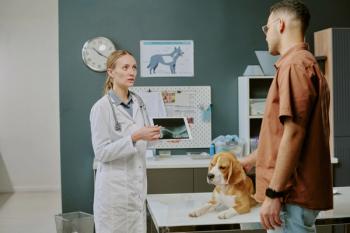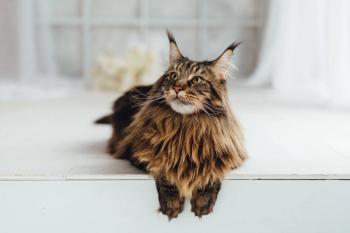
Managing diabetes mellitus in cats: What makes it work? (Sponsored by Intervet Schering-Plough Animal Health)
A technical article detailing the causes and treatment of feline diabetes mellitus.
While sometimes thought of as a disease entity, diabetes mellitus is a heterogeneous group of disorders in which insulin production is reduced or tissue cells are resistant to the effects of insulin, resulting in impaired glucose homeostasis.
In people, type I diabetes mellitus refers to the condition seen in individuals who are generally lean, young, and prone to ketogenesis. Type II diabetes mellitus usually occurs in older people who are often obese but less prone to the development of ketoacidosis. Type I diabetic patients require insulin therapy, whereas type II diabetics may be controlled—at least initially—with weight loss, diet, and oral hypoglycemic agents. This is because in type I diabetes, beta cell depletion results in a decreased insulin production and an absolute insulin deficiency. In type II diabetes, insulin receptor and postreceptor defects cause impaired insulin uptake by tissues. This insulin resistance and associated hyperglycemia cause the beta cells to produce more insulin; thus, this state is one of a relative insulin deficiency at the tissue level. Various levels of absolute or relative insulin deficiency exist (see Table 1).
Table 1. Absolute or relative insulin deficiency levels
In cats, the categorization of diabetes is not as clear. Generally, diabetes is a disorder of older, often overweight cats that are not prone to ketogenesis, more similar in signalment to type II diabetes in people. However, obese cats appear to have a defect in insulin secretion along with lower tissue sensitivity to insulin.1,2 Weight loss of even 10% to 15% results in improved tissue sensitivity, but, often by the time of diagnosis, these cats require treatment with insulin. Cats may also develop diabetes secondary to primary pancreatic disease, endocrinopathies (e.g., acromegaly, hyperadrenocorticism), or drug therapy (e.g., glucocorticoids, progestins). Risk factors for feline diabetes include weighing greater than 7 kg (15.4 lbs), not being physically active, or being over 9 years old, a neutered male, or a Burmese.1,3
Complications of unregulated diabetes mellitus
In short, diabetes mellitus results in cell starvation in the presence of hyperglycemia. While cell starvation results in polyphagia with concurrent weight loss, hyperglycemia results in polyuria and compensatory polydipsia due to glucose spilling into the urine and osmotically drawing water with it.
Some diabetic cats are affected by a polyneuropathy that can result in functional, structural, and biochemical defects in the peripheral motor and sensory nerves of the limbs. It generally affects the pelvic limbs more than the thoracic limbs.4 The pathology in nerve biopsies from 12 cats with spontaneously occurring diabetes included damage to Schwann cells, demyelination of nerve fibers, thin myelin sheaths, and an overall decrease in myelinated fiber density.5 See Table 2 for a list of functional changes associated with unregulated feline diabetes. Different than in people, diabetes does not predispose cats to hypertension, hypertensive retinopathy, or proteinuria.6
Table 2. Complications of unregulated diabetes mellitus
A recent study investigated associations among clinical signs, serum biochemical markers, and urinalysis results and found that, "Many of the cats with urinary tract infections had no clinical signs of lower urinary tract disease or changes in their laboratory values indicative of infection. Therefore, a urinalysis alone should not be used to exclude urinary tract infections in these cats."7 I recommend a urine culture for this purpose. An interesting report of pulmonary changes (such as congestion, edema, pneumonia, fibrosis, mineralization, and neoplasia) in diabetic cats without clinical signs of respiratory disease also shows the need for greater vigilance in monitoring the respiratory system.8
Another recent study looked at the prevalence of cataracts in diabetic and nondiabetic cats and concluded that all cats 17.5 years and older experienced some degree of lens opacity. Forty-eight of the 50 diabetic cats had lens opacification that was similar to that in other cats (i.e., in cats over the age of 17.5 years, there is no greater incidence of cataracts in diabetic cats than in normal cats).9
Poorly controlled diabetes in some cats may result from acromegaly, a disease characterized by hypersecretion of growth hormone due to a pituitary tumor. Studies compared measurements of insulin-like growth factor-1 (IGF-1), growth hormone, and pituitary imaging, and it appears that acromegaly is more common than previously recognized in diabetic cats.10-12
Treatment
The standard of care for diabetic cats remains the use of insulin combined with diet to achieve good glycemic control. Trying other therapies first cannot be recommended because of the glucose toxicity that occurs from uncontrolled hyperglycemia. While oral hypoglycemic therapy in cats looked promising, it has not been as successful as hoped for.13 Pancreatic islet amyloid polypeptide (IAPP) is co-secreted with insulin and IAPP deposits are thought to interfere with insulin secretion. 14 Oral hypoglycemics (e.g., sulfonylureas) may actually increase pancreatic IAPP deposition in cats.15 Using insulin combined with diet offers the best chance for remission, as well as alleviation of clinical signs and ongoing physiologic damage and subsequent complications. But what type of insulin should practitioners choose? Does an ideal insulin for cats exist?
Insulin
Type. Ideally, the goal would be to use feline insulin for cats and canine insulin for dogs so the exogenous insulin had matching amino acid sequences. However, at this time in veterinary medicine, only two animal-derived types of insulin are being produced: bovine PZI insulin, available through compounding pharmacies, and porcine insulin zinc suspension (Caninsulin/Vetsulin—Intervet), which the FDA recently approved in the United States for use in diabetic cats. Insulins that utilize human recombinant technology (Humulin—Eli Lilly and Company, Novolin GE-Novo Nordisk) are also available.
Speed and duration. Other characteristics of insulins that affect their selection and efficacy are their speed of onset and duration of action. While a spectrum exists for the speed of onset and duration of action, the four main categories are immediate-acting, short-acting, intermediate-acting, and long-acting.
Immediate- and short-acting insulins are used frequently in cats for the treatment of diabetic ketoacidosis. In general, intermediate- or long-acting insulins are the insulins of choice for daily use in nonketotic cats.
Protamine zinc insulin (PZI) is an intermediate- to long-acting, beef-pork insulin that many practitioners considered to be the insulin of choice for cats because of its molecular similarity to feline insulin. However, the PZI insulin approved for use in the United States (PZI VET—IDEXX Pharmaceuticals) has been discontinued as of April 2008.
Caninsulin is an intermediate-acting porcine insulin that has been available for more than 15 years in Australia, Canada, and Europe. It has recently been released in the United States as Vetsulin. It has just received FDA approval for use in cats and is therefore the only insulin licensed for this species. Its peak activity is at about three hours and it has a duration of action of about eight hours.16,17
Insulin glargine (Lantus—sanofi-aventis) is a long-acting human recombinant insulin analog that forms microprecipitates at the site of injection from which small amounts of insulin glargine are slowly released. Thus the glucose nadir occurs later than with intermediate-acting insulin. Lantus is different from other long-acting forms of insulin in that it starts to work within one to two hours, continues acting for about 24 hours, and does not have a peak effect.
Dose. While guidelines exist for choosing the starting dose of insulin for a cat, the maximum dose will be the dose needed to resolve the clinical signs of excessive urination and drinking, lethargy, and weakness. The majority of cats require twice daily injections, regardless of the insulin selected.
Diet
It's also important to counsel clients on the recommended diet. In the past, veterinarians recommended high-fiber diets because they believed these were absorbed more slowly, helping to regulate blood glucose levels. This does not seem to be the case for cats. Lower carbohydrate diets may be as—or more—effective.18 Currently, there is also interest in higher-protein diets to improve blood glucose regulation.
Recent studies that looked at the effects of feeding different diets on glycemic control in cats support the use of low-fiber, low-carbohydrate diets. Diabetic cats in one study were significantly more likely to revert to a noninsulin-dependent state when fed the low-fiber, low-carbohydrate canned diets vs. the moderate-carbohydrate high-fiber diets.19
Another study looked at feeding high-carbohydrate diets compared with high-fat diets and found that cats on the high-fat diet showed a slightly elongated glucose clearance and reduced acute insulin response to glucose administration.20 So fiber may be beneficial in some cats.21 No one really knows if there is a single diet recommendation that can be made that will benefit all diabetic cats. Keep in mind that diets may need to be adjusted when regulating an individual patient's blood glucose.
Based on my mostly successful management of feline diabetics, I personally believe that cats should have free access to higher-protein, low-carbohydrate food all the time—rather than feeding twice daily—because this reflects more closely the natural feeding behavior and, hence, insulin secretion of cats.
Follow-up care
After making the diagnosis, we teach our clients about what is happening in their cat's body and why they are seeing the changes (polyuria, polydipsia, polyphagia, and weight loss). Then we teach them to record in a diary their observations of these clinical signs needed for evaluation of progression or resolution of the condition, such as thirst and urine volume. At the same time, we schedule a follow-up appointment two weeks later for a blood glucose curve. Tell the client to expect daily calls from the hospital during the three to four days following diagnosis for support and questions. The calls also serve as a follow-up on the cat's condition and helps staff ascertain that the client is keeping the clinical signs observation diary.
At the first appointment for a blood glucose curve, we take hourly measurements, adjust the insulin dose as indicated, discuss the diary notations and trends with the client, and teach them how to measure glucose by ear prick. At this time, I want them to learn to be comfortable with this technique. After the subsequent, two week, in-clinic blood glucose curve, we ask them to perform the curves at home and report the results to us for dose adjustment and discussion. Avoid spot checking blood glucose concentrations because they can be misleading and mask the Somogyi effect. The exception to this would be the clients spot checking blood glucose concentrations at home if their cat "doesn't look right" before deciding whether to give insulin. Monitoring a diabetic cat using only serum fructosamine concentrations without blood glucose curves will also miss the Somogyi effect and, because the fructosamine will be elevated in these cats, can result in a life-threatening, incorrect therapeutic decision to increase the insulin dose.
I do not routinely ask clients to monitor urine glucose or ketones at home because even well-regulated cats may have some glucosuria. However, justified occasions to monitor urine parameters at home include:
- To help provide more information when trying to sort out discrepancies in glucose values and clinical findings (e.g., an acceptable blood glucose curve but polyuria/polydipsia and weight loss still present)
- To identify when or if glucosuria recurs in cats with transient diabetes
- To determine if glucosuria resolves in cats on oral hypoglycemics
- To monitor for ketones in previously or currently ketoacidotic cats.
During the month or two following diagnosis, by performing and evaluating blood glucose curves, measuring serum fructosamine concentrations, and reassessing the cat clinically and historically (i.e., with the client's diary) every two weeks, you will determine the insulin dose suitable for the patient. Thereafter, it is advisable to see stable diabetic cats every four to six months for a physical examination and a serum fructosamine concentration test. During these rechecks, also consider collecting a sterile urine sample for urinalysis and culture because diabetic cats are more prone to bacterial urinary tract infections than nondiabetic cats. If a diabetic cat becomes ill, then perform a glucose curve (assuming the cat is eating) as well as any other tests appropriate for the cat's condition.
Conclusion
From a clinical perspective, diabetes mellitus can be challenging to diagnose, monitor, and treat in cats. Keep in mind that it generally takes two to three months to regulate a newly diagnosed cat and recognize that cats respond to a different set of rules than dogs. With a realistic outlook and a different set of expectations, both the healthcare team and clients will be less frustrated, more patient, and more persistent when observing the cat and performing the appropriate testing to achieve and maintain good glycemic control.
References
1. Appleton DJ, Rand JS, Sunvold GD. Insulin sensitivity decreases with obesity, and lean cats with low insulin sensitivity are at greatest risk of glucose intolerance with weight gain. J Feline Med Surg 2001;3:211-228.
2. Hoenig M, Alexander S, Holson J, et al. Influence of glucose dosage on interpretation of intravenous glucose tolerance tests in lean and obese cats. J Vet Intern Med 2002;16:529-532.
3. McCann TM, Simpson KE, Shaw DJ, et al. Feline diabetes mellitus in the UK: The prevalence within an insured cat population and a questionnaire-based putative risk factor analysis. J Feline Med Surg 2007;9:289-299.
4. Mizisin AP, Shelton GD, Burgers ML, et al. Neurological complications associated with spontaneously occurring feline diabetes mellitus. J Neuropathol Exp Neurol 2002;61:872-884.
5. Mizisin AP, Nelson RW, Sturges BK, et al. Comparable myelinated nerve pathology in feline and human diabetes mellitus. Acta Neuropathol 2007;113:431-442.
6. Sennello KA, Schulman RL, Prosek R, et al. Systolic blood pressure in cats with diabetes mellitus. J Am Vet Med Assoc 2003;223:198-201.
7. Mayer-Roenne B, Goldstein RE, Erb HN. Urinary tract infections in cats with hyperthyroidism, diabetes mellitus and chronic kidney disease. J Feline Med Surg 2007;9:124-132.
8. Mexas AM, Hess RS, Hawkins EC, et al. Pulmonary lesions in cats with diabetes mellitus. J Vet Intern Med 2006;20:47-51.
9. Williams DL, Heath MF. Prevalence of feline cataract: Results of a cross-sectional study of 2,000 normal animals, 50 cats with diabetes and one hundred cats following dehydrational crises. Vet Ophthalmol 2006;9:341-349.
10. Reusch CE, Kley S, Casella M, et al. Measurements of growth hormone and insulin-like growth factor 1 in cats with diabetes mellitus. Vet Rec 2006;158:195-200.
11. Alt N, Kley S, Tschuor F, et al. Evaluation of IGF-1 levels in cats with transient and permanent diabetes mellitus. Res Vet Sci 2007;83:331-335.
12. Niessen SJ, Petrie G, Gaudiano F, et al. Feline acromegaly: An underdiagnosed endocrinopathy? J Vet Intern Med 2007;21:899-905.
13. Mazzaferro EM, Greco DS, Turner AS, et al. Treatment of feline diabetes mellitus using an alpha-glucosidase inhibitor and a low-carbohydrate diet. J Feline Med Surg 2003;5:183-189.
14. O'Brien TD. Pathogenesis of feline diabetes mellitus. Mol Cell Endocrinol 2002;197:213-219.
15. O'Brien TD, Butler Pc, Westermark P, et al. Islet amyloid polypeptide: a review of its biology and potential roles in the pathogenesis of diabetes mellitus. Vet Pathol 1993;34:317-332.
16. Martin GJ, Rand JS. Comparisons of different measurements for monitoring diabetic cats treated with porcine insulin zinc suspension. Vet Rec 2007;161:52-58.
17. Martin GJ, Rand JS. Control of diabetes mellitus in cats with porcine insulin zinc suspension. Vet Rec 2007;161:88-94.
18. Rand JS, Marshall RD. Diabetes mellitus in cats. Vet Clin North Am Small Anim Pract 2005;35:211-224.
19. Bennett N, Greco DS, Peterson ME, et al. Comparison of a low carbohydrate-low fiber diet and a moderate carbohydrate-high fiber diet in the management of feline diabetes mellitus. J Feline Med Surg 2006;8:73-84.
20. Thiess S, C Becskei C, Tomsa K, et al. Effects of high carbohydrate and high fat diet on plasma metabolite levels and on i.v. glucose tolerance test in intact and neutered male cats. J Feline Med Surg 2004;6:207-218.
21. Kirk CA. Feline diabetes mellitus: Low carbohydrates versus high fiber? Vet Clin North Am Small Anim Pract 2006;36:1297-1306.
Newsletter
From exam room tips to practice management insights, get trusted veterinary news delivered straight to your inbox—subscribe to dvm360.




